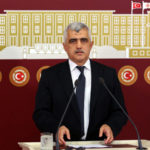No leader stays in power or lives forever, and Turkey’s dictator is getting old.
Recep Tayyip Erdogan has dominated Turkish politics for much of the last two decades. He is the most consequential leader in Turkey since Mustafa Kemal Atatürk who founded modern Turkey almost a century ago. While Atatürk sought to tie Turkey to the West, Erdogan has worked to reorient Turkey instead to the Islamic world. He built a palace, fifty-eight-times the size of the White House, where he lives like a Sultan. Indeed, that may his goal as he increasingly promotes his own family over party. Erdogan demands respect. He surrounds himself with courtiers who praise him constantly and imprisons those whose criticize him. While Erdogan sees himself as larger than life, the true measure of how Turks view him will become apparently only after his death.
Erdogan’s demise is a topic about which Turks increasingly speculate. On February 24, Erdogan will turn sixty-seven. He has had multiple health scares. In 2006, he passed out in a locked, armored car causing panic among his desperate bodyguards. A decade ago, Erdogan underwent surgery for colon cancer. In 2017, he fainted while praying at a mosque. He is also allegedly an epileptic. Nor can Erdogan be certain about a peaceful death. Every democrat awakes knowing when his term in office expires; dictators awake recognizing on some level that any day could be their last. Erdogan may get his state funeral, but he also may live out his final days in exile.
How might Turks honor Erdogan after his death? Turkey often treats its leader with more respect after they die than when they were alive. Turkey has long been politically polarized. Over the decades, party gangs have done battle on the streets as their leaders sometimes came to blows in the parliament, but partisan animosity toward leaders fade with time.
The most respected figure in Turkey remains Mustafa Kemal Atatürk who founded the modern republic almost a century ago. His mausoleum, the Anıtkabir, towers above a leafy neighborhood in central Ankara. Prior to Ankara’s explosive growth, residents across the hilly city could, like a modern acropolis, see it. Tourists, school groups, diplomats, and visiting military delegations continue to visit it and the same-complex tomb of Atatürk successor İsmet İnönü on an almost daily basis.
Atatürk’s shrine might be the largest, but he is not the only Turkish leader honored with a mausoleum. In 1960, the military ousted Prime Minister Adnan Menderes, who led Turkey through the 1950s, and executed him the following year. While they initially buried him in a small plot within the shadow of İmralı, Turkey’s highest-security prison, Turkish authorities ultimately rehabilitated him and constructed a mausoleum in Istanbul where he now rests. Menderes’ colleague Celâl Bayar, president at the time of the 1960 coup and sentenced to life imprisonment by the same court that condemned Menderes, served only three years, and died in 1986 at age 103. The Turkish government honored him with a museum and mausoleum in Bursa.
One of modern Turkey’s most famous statesmen was Süleyman Demirel, who rose to power in 1965, ruled Turkey for the next six years, and returning to power three subsequent times against the backdrop of political instability over the next decade, and then once more in the early 1990s as head of the True Path Party. Widely respected, he became president of Turkey in 1993 and led in that capacity into the new millennium. When Demirel died at ninety years old, he was buried in Atabey, the town of his birth where the Turkish government subsequently constructed a mausoleum.
Nor was he alone. Turgut Özal, whose center-right Motherland Party dominated Turkish politics for a decade after the return to civilian rule in 1983, was laid to rest (twice) with honors at a mausoleum near Topkapı Palace in central Istanbul.
Center-left leader Bülent Ecevit who served as prime minister four times between 1974 and 2002 did not get a mausoleum but nevertheless received state honors at the Turkish State Cemetery in Ankara, where Turkey also interred Cemal Gürsel, Cevdet Sunay, Fahri Korutürk, Kenan Evren, the fourth through seventh presidents who lead the country consecutively from 1961 to 1989. Necmettin Erbakan, Turkey’s first Islamist leader and Erdogan’s former mentor, received a more modest burial at the Merkezefendi Cemetery in Istanbul.
Erdogan revels in the image of a pious Muslim but, behind closed doors, eschews the ascetic life. Whereas Erbakan requested a simple funeral, if Erdogan’s 1,000-room residence is any indication, he will expect far more.
He may not get it. Like Erdogan, Ayatollah Ruhollah Khomeini amassed a fortune while seeking to project an image of material disinterest. Upon his death, the Islamic Republic built a huge mausoleum along the highway between Tehran and Qom. When I first visited it in 1996, it was set up like many Shi’ite shrines with an inner sanctum in which a silver cage encased his coffin. Pilgrims would insert cash through the cage. When I returned three years later, Plexiglas sealed off the cage. I asked some guards why, and they said Iranians would fold feces into bills and push them toward the coffin. Shrine size is not always proportional to respect.
Vengeance might also sully Erdogan’s desire for post-mortem honor. Erdogan is Turkey’s most hated man. The hundreds of thousands who he has fired, imprisoned, or revoked pensions from will not soon forgive him. Vandals broke into Argentine dictator Juan Peron’s tomb in 1987 and took a chainsaw to his corpse. During Iran’s Islamic Revolution, Khomeini destroyed memorials to his immediate predecessors. Only recently did Iranians by chance find the mummified remains of Reza Shah, who led the country from 1925 until 1941. Muhammad Reza Shah, the last shah, remains buried in Cairo exile. Idi Amin, too, lived a luxurious life across multiple palaces in Uganda, turning Mukusu Island on Lake Victoria into a personal resort. Forced into exile, however, Amin now rests under a non-descript grave in Jeddah, Saudi Arabia. Longtime Tunisian dictator Zine El Abidine Ben Ali likewise is buried just 250 miles north in Medina. Erich Honecker, lived a luxurious life as East Germany’s longtime leader, but now lies in a small Chilean graveyard.
Erdogan’s tenure as prime minister and president have shown Turks and the world that he is a fragile, thin-skinned, venal man, more content to crush dissent than win a policy debate on its merits. Over the course of his career, he has not only antagonized many Turks, but he has also made himself persona non grata among regional states and Turkey’s traditional allies. He may believe his legacy will be as a second Atatürk, but visitors may be sparse. After all, it is difficult for Turkish students to easily visit shrines in Azerbaijan, Qatar, or Somalia.
By: Michael Rubin
Source: National Interset



